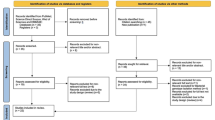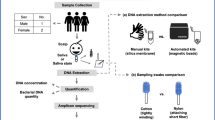Abstract
When fingermarks are left on a surface, bacteria originating from the donor’s skin are also deposited. The skin microbiome is believed to be extremely diverse between individuals, allowing for potential matching between the bacterial communities and touched objects, known as “bacterial profiling”. This study stepped further and investigated how the bacterial profile could be used as an indicator of donor characteristics of potential forensic intelligence interest. Forty-five participants were asked to touch DNA-free playing cards with their dominant and non-dominant hands. Cards were swabbed and bacterial communities determined through 16S rRNA sequencing. Diversity and abundance of bacteria were compared to donor characteristics of gender, age, ethnicity, handedness, home location, sample location, occupation, diet type, use of moisturisers, use of hand sanitisers and use of public transport. Correlations between the bacterial profile with gender, ethnicity, diet type and hand sanitiser use were found. Specifically, the absence of Lactococcus indicated a primarily Chinese diet, while the absence of Alloiococcus indicated female gender, Asian ethnicity and hand sanitiser use. Testing of the prediction models demonstrated highest accuracy for gender estimation, while the prediction of other characteristics showed lower success. This study showed a correlation between the presence of certain bacterial species on donor’s hands and personal characteristics of potential forensic relevance, thus demonstrating a novel application of microbiome genotyping in forensic science.




Similar content being viewed by others
References
Stoilovic M, Lennard C (2012) Fingermark detection and enhancement, 6th edn. National Centre for Forensic Studies, Canberra
Champod C (2016) Fingerprints and other ridge skin impressions. CRC Press, Taylor & Francis Group, Boca Raton
van Dam A, van Beek FT, Aalders MC, van Leeuwen TG, Lambrechts SA (2016) Techniques that acquire donor profiling information from fingermarks—a review. Sci Justice 56:143–154
Human Microbiome Project Consortium (2012) Structure, function and diversity of the healthy human microbiome. Nature 486:207–214
Costello EK, Lauber CL, Hamady M, Fierer N, Gordon JI, Knight R (2009) Bacterial community variation in human body habitats across space and time. Science 326:1694–1697
Gao Z, Tseng CH, Pei Z, Blaser MJ (2007) Molecular analysis of human forearm superficial skin bacterial biota. Proc Natl Acad Sci U S A 104:2927–2932
Fierer N, Hamady M, Lauber CL, Knight R (2008) The influence of sex, handedness, and washing on the diversity of hand surface bacteria. Proc Natl Acad Sci U S A 105:17994–17999
Grice EA, Kong HH, Renaud G, Young AC, Program NCS, Bouffard GG, Blakesley RW, Wolfsberg TG, Turner ML, Segre JA (2008) A diversity profile of the human skin microbiota. Genome Res 18:1043–1050
Song SJ, Lauber CL, Costello EK, Lozupone CA, Humphrey G, Berg-Lyons D, Caporaso JG, Knights D, Clemente JC, Nakielny S, Gordon JI, Fierer N, Knight R (2013) Cohabiting family members share microbiota with one another and with their dogs. eLife 2:e00458
Hospodsky D, Pickering AJ, Julian TR, Miller D, Gorthala S, Boehm AB, Peccia J (2014) Hand bacterial communities vary across two different human populations. Microbiology 160:1144–1152
Leung MH, Wilkins D, Lee PK (2015) Insights into the pan-microbiome: skin microbial communities of Chinese individuals differ from other racial groups. Sci Rep 5:11845
Lax S, Smith DP, Hampton-Marcell J, Owens SM, Handley KM, Scott NM, Gibbons SM, Larsen P, Shogan BD, Weiss S, Metcalf JL, Ursell LK, Vazquez-Baeza Y, Van Treuren W, Hasan NA, Gibson MK, Colwell R, Dantas G, Knight R, Gilbert JA (2014) Longitudinal analysis of microbial interaction between humans and the indoor environment. Science 345:1048–1052
Fierer N, Lauber CL, Zhou N, McDonald D, Costello EK, Knight R (2010) Forensic identification using skin bacterial communities. Proc Natl Acad Sci 107:6477–6481
Yao X, Liu W, Han J, Pei G, Tong Y, Luo Y (2016) Analysis of microbiome DNA on frequently touched items and from palm prints. J Forensic Sci Med 2:74–77
Meadow JF, Altrichter AE, Green JL (2014) PeerJ 2:e477. https://doi.org/10.7717/peerj.7447
Lax S, Hampton-Marcell J, Gibbons SM, Colares GB, Smith D, Eisen JA, Gilbert JA (2015) Forensic analysis of the microbiome of phones and shoes. Microbiome 3:21
Lee S, Woo S, Choi G, Hong Y, Eom Y (2015) Microbial forensic analysis of bacterial fingerprint by sequence comparison of 16S rRNA gene. J Forensic Res 6:297
Schmedes SE, Woerner AE, Budowle B (2017) Forensic human identification using skin microbiomes. Appl Environ Microbiol 83:e01672–e01617
Lee S, Woo S, Lee S, Eom Y (2016) Forensic analysis using microbial community between skin bacteria and fabrics. Toxicol Environ Heal Sci 8:263–270
Turner S, Pryer KM, Miao VP, Palmer JD (1999) Investigating deep phylogenetic relationships among cyanobacteria and Plastids by small subunit rRNA sequence analysis. J Eukaryot Microbiol 46:327–338
Caporaso JG, Kuczynski J, Stombaugh J, Bittinger K, Bushman FD, Costello EK, Fierer N, Gonzalez Pena A, Goodrich JK, Gordon JI, Huttley GA, Kelley ST, Knights D, Koenig JE, Ley RE, Lozupone CA, McDonald D, Muegge BD, Pirrung M, Reeder J, Sevinsky JR, Turnbaugh PJ, Walters WA, Widmann J, Yatsunenko T, Zaneveld J, Knight R (2010) QIIME allows analysis of high-throughput community sequencing data. Nat Methods 7:335–336
Lozupone CA, Hamady M, Kelley ST, Knight R (2007) Quantitative and qualitative diversity measures lead to different insights into factors that structure microbial communities. Appl Environ Microbiol 73:1576–1585
Segata N, Izard J, Waldron L, Geveres D, Miropolsky L, Garrett WS, Huttenhower C (2011) Metagenomic biomarker discovery and explanation. Genome Biol 12:R60
Multinu F, Harrington SC, Chen J, Jeraldo PR, Johnson S, Chia N, Walther-Antonio MR (2018) Systematic bias introduced by genomic DNA template dilution in 16S rRNA gene-targeted microbiota profiling in human stool homogenates. mSphere 3:e00560–e00517
Cosseau C, Romano-Bertrand S, Duplan H, Lucas O, Ingrassia I, Pigasse C, Roques C, Jumas-Bilak E (2016) Proteobacteria from the human skin microbiota: species-level diversity and hypotheses. One Health 2:33–41
Bobulsky GS, Al-Nassir WN, Riggs MM, Sethi AK, Donskey CJ (2008) Clostridium difficile skin contamination in patients with C. difficile-associated disease. Clin Infect Dis 46:447–450
Budowle B, Murch R, Chakraborty R (2005) Microbial forensics: the next forensic challenge. Int J Legal Med 119:317–330
Clarke TH, Gomez A, Singh H, Nelson KE, Brinkac L (2017) Integrating the microbiome as a resource in the forensics toolkit. Forensic Sci Int Genet 30:141–147
Gunn A, Pitt SJ (2012) Microbes as forensic indicators. Trop Biomed 29:311–330
Hampton-Marcell J, Lopez JV, Gilbert JA (2017) The human microbiome: an emerging tool in forensics. Microb Biotechnol 10:228–230
Leake SL (2013) Is human DNA enough?—potential for bacterial DNA. Front Genet 4:1–3
Tidico SR, Murray DC, Addison J, Kirkbride KP, Bunce M (2014) Metagenomic analyses of bacteria on human hairs: a qualitative assessment for applications in forensic science. Investig Genet 5:16
Tano K, von Essen R, Eriksson P-O, Sjostedt A (2008) Alloiococcus otitidis-otitis media pathogen or normal bacterial flora? Acta Pathol Microbiol Immunol Scand 116:785–790
Yoshiura K, Kinoshita A, Ishida T, Ninokata A, Ishikawa T, Kaname T, Bannai M, Tokunga K, Sonoda S, Komaki R, Ihara M, Saenko VA, Alipov GK, Sekine I, Komatsu K, Takahashi H, Nakashima M, Sosonkina N, Mapendano CK, Ghadami M, Nomura M, Liang DS, Miwa N, Kim DK, Garidkhuu A, Natsume N, Ohta T, Tomita H, Kaneko A, Kikuchi M, Russomando G, Hirayama K, Ishibashi M, Takahashi A, Saito N, Murray JC, Saito S, Nakamura Y, Niikawa N (2006) A SNP in the ABCC11 gene is the determinant of human earwax type. Nat Genet 38:324–330
Sumikawa Y, Takahashi H, Sumikawa M, Kusatake K, Kaneko S, Yamashita T, Morita E (2013) J Clin Exp Dermatol Res 4:100193
Luebberding S, Krueger N, Kerscher M (2013) Skin physiology in men and women:in vivoevaluation of 300 people including TEWL, SC hydration, sebum content and skin surface pH. Int J Cosmet Sci 35:477–483
Author information
Authors and Affiliations
Corresponding author
Ethics declarations
All subjects were made aware of the nature of the study and gave written consent before any information gathering or sampling occurred. This study has been approved by the University of Technology Sydney Human Research Ethics committee (UTS HREC approval #2015000296).
Conflict of interest
The authors declare that they have no conflict of interest.
Additional information
Publisher’s note
Springer Nature remains neutral with regard to jurisdictional claims in published maps and institutional affiliations.
Electronic supplementary material
The following files are available online: Table S1 – Bacterial groups identified as potential biomarkers using the LefSe pipeline; Table S2 – Association between Factors; Table S3 – Participant Intrinsic and Extrinsic Factors.
ESM 1
(DOCX 47 kb)
Rights and permissions
About this article
Cite this article
Phan, K., Barash, M., Spindler, X. et al. Retrieving forensic information about the donor through bacterial profiling. Int J Legal Med 134, 21–29 (2020). https://doi.org/10.1007/s00414-019-02069-2
Received:
Accepted:
Published:
Issue Date:
DOI: https://doi.org/10.1007/s00414-019-02069-2




